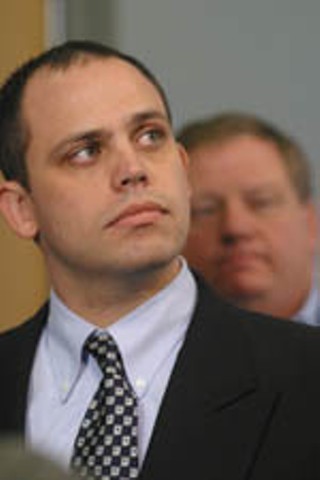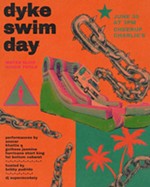New Questions Raised in Owens Shooting
DNA tests and an eyewitness account seem to not match the official story
By Jordan Smith, Fri., April 16, 2004

Just after midnight last June 14, Rochelle Williams was lying in bed in her house on Tillery Street when she heard gunfire – four evenly spaced, but not rapid, shots. She didn't immediately get out of bed – rising and looking out the window while a gun was firing seemed a bad idea. But less than a minute later, she heard the alarm sound on her Ford Expedition, and she rose and peered through the east-facing window at her bedside. Outside in her front yard, "sitting where my [Ford] had been parked" minutes before, she said, was a red Dodge Neon, its lights on and its hood scooped where it had plowed into the back of her truck.
Through the Neon's partially opened driver's side window, Williams heard a steady bass line of music, and she could see red and blue police lights reflecting from a house across the street and slightly south, down Tillery. She couldn't see a police car or, for that matter, any people. Yelling to her brother that her car had just been hit, Williams walked the short distance from her bedroom to the front door where she met her brother coming from his room. By the time they opened the front door – no more than a minute or two after Williams heard the alarm – she was surprised to see six or seven officers, with their guns drawn, surrounding the Neon, where a lone male occupant was in the driver's seat, his upper body slightly twisted and slumped, face up, onto the passenger seat. A female officer yelled to Williams to go inside and close the door. She did so, then went to her living room window to look outside.
Williams would have to wait a while longer to learn the story that had just ended at her doorstep. After following 20-year-old Jessie Lee Owens on suspicion of driving a stolen car, Austin Police Officer Scott Glasgow shot Owens five times, after, the officer says, Owens dragged him down the street in either a misguided attempt to flee or a conscious attempt to use the Neon as a deadly weapon. (See "'Something Went Wrong,'" News, Dec. 12.) In October, Glasgow was indicted for criminally negligent homicide by a Travis Co. grand jury, but on Jan. 15 the indictment was quashed in court. On Feb. 9, Austin Police Chief Stan Knee suspended Glasgow for 90 days without pay for violating department policy governing "high-risk" traffic stops and for failing to use "good judgment."
That decision didn't appear to satisfy anyone. Glasgow's supporters considered the suspension unfounded – Glasgow had been cleared for the shooting, but was suspended for policy violations that are, in fact, procedural guidelines and not imperatives. Owens' family viewed the decision to suspend instead of to fire Glasgow as a slap in the face. The city Office of the Police Monitor's Citizen Review Panel also weighed in, expressing consternation at Knee's choice to suspend instead of terminate Glasgow.
The local case is ostensibly closed, but a few questions remain open. Owens' family has asked the federal government, including the U.S. Department of Justice Civil Rights Division, to review the case. (At press time, DOJ representatives had not returned calls requesting comment.) And Williams said that she knows that Glasgow's version of what transpired on June 14 has received several official reviews – by APD homicide detectives, Internal Affairs, and by the OPM – and has been accepted as fact. But she remains unconvinced that the story is, in fact, complete.
According to Glasgow, he reached inside the Neon in an attempt to extract Owens from the car because the driver's door would not fully open (in part because Glasgow's patrol car was parked so close), and that Owens pulled the door shut and tried to drive away, trapping and then dragging Glasgow along with him. Williams says that scenario doesn't make sense to her, in part because Owens' window was partially rolled down: Why would Glasgow need to reach over the door?
Later that night, while the responding officers were busy working farther down the street, Williams said she went out into her front yard to survey the damage when she noticed Glasgow's gun, embedded in the mud, within the tire track impression left by the Neon as it jumped the curb in front of her house. If Glasgow had been trapped inside the car with his gun drawn, she asks, how did the pistol land squarely within the car's path? "It might've happened the way Officer Glasgow says it did, but some of the things he said don't seem to add up," she said.
Williams isn't alone in questioning the official version of events. "If the gun was under the car how could it be in the car?" asks Bob Mann, who has been acting as a spokesman for the Owens family. That bit of evidence alone, he said, suggests a problem with Glasgow's story. Other sources close to the case agree, and they point as well to a Jan. 6 DNA lab report from the Texas Department of Public Safety as evidence. According to the report, APD investigators on July 17 submitted two swabs for analysis, one taken from the Neon's door frame and the other taken from the door's rubber seal – apparently to match the physical evidence with Glasgow's accounting. After analyzing the swabs against known DNA samples from Owens and from Glasgow, DPS analyst Debora Furman wrote that the door swab samples contained a mixture of DNA and that while Owens "cannot be excluded" as a contributor to the sample, Glasgow could be excluded: "The DNA profiles ... are not consistent with the DNA profile of Scott Glasgow," Furman wrote. At least one source close to the Owens case finds that exclusion troubling: "I could understand if neither of them were matched to the sample," the source said, "but how could Owens' DNA be there without Glasgow's? Are you going to try to tell me that he didn't shed any skin cells as he was being dragged down the street?"
Glasgow's supporters think the latest round of questions about the shooting are inconsequential. "We believe that our homicide unit did a very thorough investigation out there," said Mike Sheffield, president of the Austin Police Association. "And we absolutely believe in and trust their investigation." He said there are several possible explanations for the lack of Glasgow's DNA on the Neon door frame – perhaps that the short sleeves of Glasgow's uniform kept his arms from rubbing against the frame. "Internal Affairs also did an investigation on this," he points out, "and none [of the department's investigations] have cast any doubt on Glasgow's version of events."
Owens' great-aunt Hazel Obey remains frustrated but says her family is willing to accept the results of any investigation that actually answers all the questions still pending – which she insists hasn't yet happened. "The whole thing is really very, very weird," she said. Williams was never interviewed as part of the Glasgow investigation – she refused an initial request by homicide detectives, she says, because she was uncomfortable with them. She wrote a letter to then Police Monitor Iris Jones that explained her initial reticence and offered to make herself available for questioning, but she was never again contacted. She provided a brief statement to the District Attorney's Office, but was never called to testify before the grand jury.
Now, nearly a year later, Glasgow's suspension is almost over, and he is slated to return to work next month. Williams says she remains stuck on June 14, 2003. Her house, she said, still attracts "gawkers" who drive by at all times of the day and night to see the spot where Owens died, and she feels guilty and wonders if she might have been able to do something to stop the shooting – if she'd stayed awake watching TV a little longer, she said, or could have known, somehow, what was about to happen outside her house. "I'm sorry for [Owens'] family, and I'm sorry for the officer," she said, "but, regardless, we need the truth."
Got something to say on the subject? Send a letter to the editor.










